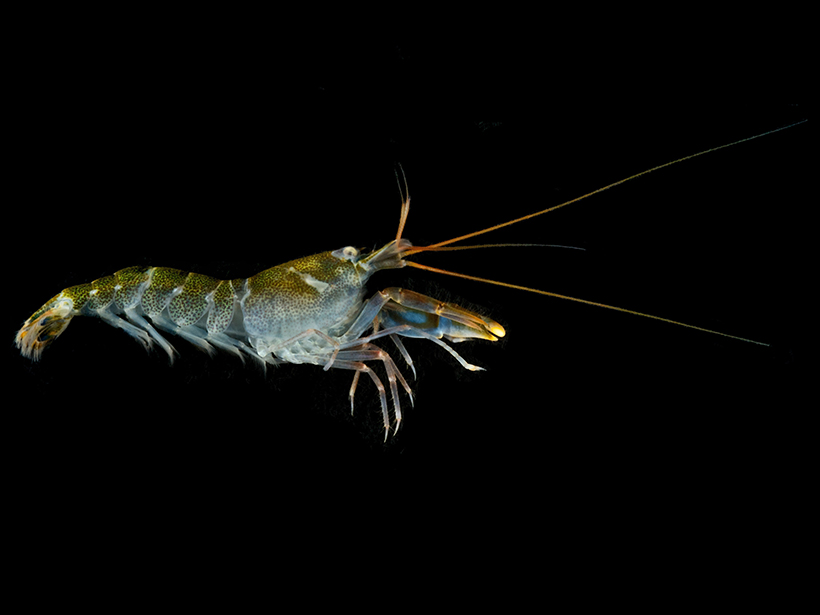A translation of this article was made possible by a partnership with Planeteando. Una traducción de este artículo fue posible gracias a una asociación con Planeteando.
For animals no longer than a stick of chewing gum, snapping shrimp make an impressive racket. En masse, they create what sounds like pervasive crackling, and the din gets even louder when the shrimp live in warmer water, new research has revealed. Because many marine creatures navigate, forage, and find mates on the basis of sound, a noisier underwater soundscape—a by-product of climate change—could have far-reaching effects, the scientists suggest.
Millions of Noisemakers
Snapping shrimp might be tiny, but they’re a mainstay in the ocean. “There are thousands or potentially millions of these shrimp in all of the crevices of, say, a coral reef,” said Ashlee Lillis, a marine ecologist at The Nature Conservancy in Saint Croix, U.S. Virgin Islands. “You can’t really get away from them.”
“Snapping shrimp are a big component of the soundscape.”
The animals produce snaps over a wide range of frequencies, from tens of hertz to over hundreds of kilohertz. Other marine creatures, like lobsters, whales, and dolphins, are also sensitive to sounds within this range. The snaps are loud enough to be picked up easily by instruments: During World War II, U.S. military efforts to scan the ocean with sonar were sometimes thwarted by a cacophony of snapping shrimp.
“Snapping shrimp are a big component of the soundscape,” said Bob Dziak, an oceanographer at the National Oceanic and Atmospheric Administration (NOAA) and the Pacific Marine Environmental Laboratory in Newport, Ore., not involved in the research.
Imploding Bubbles
Snapping shrimp make their characteristic snaps by rapidly closing a disproportionately large claw. But it’s not claw-on-claw scraping that produces the sound, which can top 200 decibels for a fraction of a second. Instead, the movement of the closing claw displaces water, which travels fast enough—roughly 25–35 meters per second—to experience a significant drop in pressure, thanks to Bernoulli’s principle. Tiny air bubbles entrained within the water accordingly expand, but they implode within a millisecond as the water slows down again and the pressure increases, another research team demonstrated 2 decades ago. It’s these implosions that produce the snapping shrimps’ snaps, those researchers concluded on the basis of high-speed videography.
The snaps probably serve a variety of purposes. They might be a form of territorial defense or a way of communicating with other animals. And they probably play a role in feeding because they’ve been shown to stun and kill prey.
A few years ago, while studying oysters off the coast of North Carolina, Lillis and her colleagues observed that snapping shrimp sometimes changed their snapping cadence. The variability was correlated with water temperature, the team realized. “If there’s a temperature anomaly just over a few hours or a few days, the snapping activity changes,” said Lillis. Lillis and her colleague Aran Mooney at the Woods Hole Oceanographic Institution in Woods Hole, Mass., decided to test that correlation in the laboratory.
Shrimp in the Lab
The team collected shrimp of the genus Alpheus, which are commonly found in the southeastern United States and the Gulf of Mexico. Using hydrophones, the scientists recorded the snaps the shrimp produced when they were placed in 10°C, 20°C, or 30°C water. For each of the setups the researchers tested—housing the shrimp singly, in pairs, or in colonies of 10 animals—their snap rate increased in warmer water. For instance, in 10°C water, the colonies’ median snap rate was less than 50 per day; in 30°C water, that value increased over tenfold. A higher snapping rate translates into a noisier environment, said Lillis, who was at the Woods Hole Oceanographic Institution when this work was conducted. So as the oceans continue to warm as a result of climate change, they’re going to get louder because of these tiny creatures.

A louder ocean soundscape might have far-reaching repercussions, said NOAA’s Dziak. “Most marine animals use sound to communicate, navigate, and find food,” he said. “Anything that’s raising the background noise level is going to potentially interfere with other marine animals.”
These results were presented last month at Ocean Sciences Meeting 2020 in San Diego, Calif.
—Katherine Kornei (@KatherineKornei), Science Writer
Citation:
Kornei, K. (2020), Snapping shrimp pump up the volume in warmer water, Eos, 101, https://doi.org/10.1029/2020EO141178. Published on 10 March 2020.
Text © 2020. The authors. CC BY-NC-ND 3.0
Except where otherwise noted, images are subject to copyright. Any reuse without express permission from the copyright owner is prohibited.

